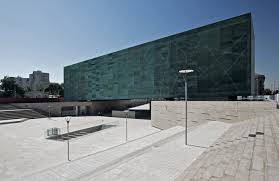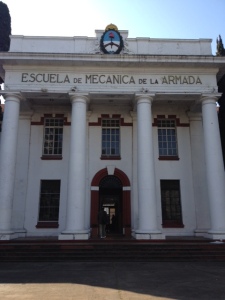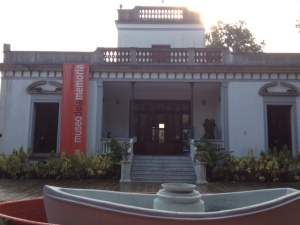Once I decided to travel to Chile to start my Summer Program I had no doubts that my internship would be at the Museo de la Memoria. This place offered me the chance to delve more into what means to be an exile, its repercussions, the factors shaping identity and, specially, to keep alive the memory of the atrocities committed by the dictatorship for future generations. Though, I will explain in detail what I am doing at the Museo in another post, suffice is to say that I have been wondering about the role of these institutions in society; specially, in relation to the specific type of dictatorships that plagued the Southern Cone. I had the chance to travel to Buenos Aires and Montevideo and visit their Museos de la Memoria and compare them to the one in Santiago.
I want to share two conclusions out of what I saw in my trips. The first one is related to the public knowledge of these places. My second observation deals with their infrastructure. I could be wrong but I think that the size and the architecture of the museums symbolize the importance that these societies place on memory and the way they address or look at their recent past.
Let’s start with the Museo de la Memoria y los Derechos Humanos in Santiago. When I arrived here I was surprised by the fact that most of the people I met in the streets or in the classroom knew something about this place. Some just had heard about it but others told me about their experiences there and the multiple times they went (for academic reasons or just voluntarily). Anyways, the impression that they left me was that they were aware of the existence of this institution and actively invited me to go there. The next stop was Buenos Aires. There I was thrilled by the idea of visiting the Espacio Memoria y Derechos Humanos; this cultural center is impressive because it was the headquarters where the military carried out policies of torture and extermination against the population. Therefore, like Auschwitz, it has a strong emotional and historical connotation. Nonetheless, I was more surprised by the fact that less people care about it. Someone even told me that it could be boring and I should visit other places since I was staying there only for 3 days. In any case, the Argentinians I talked to were aware of this place but didn’t find it interesting. In Montevideo things were different. I was really shocked by the lack of public knowledge about their own Museo de la Memoria. It was difficult for me to find someone who knew where the place was located. I asked bus drivers specially; some of them didn’t know about it at all and others mistook it for another museum (Museo Juan Manuel Blanes). In fact, I spoke with people of my age and they had no clue about what I was talking. That’s when I realized that there were important differences in the way these three societies approached their past.
I want to be clearer about this last point. For that reason let’s consider the infrastructure of these Museos.
Here, there are two things worth analyzing; the building and its location. In the case of Santiago and Buenos Aires we are talking about big places. The Espacio Memoria y Derechos Humanos has several buildings (with the ESMA and the Casino de Oficiales being the most important ones) forming together a huge complex. Besides, it is a place with an historical meaning. The Museo de la Memoria y los Derechos Humanos lacks the latter but undoubtedly shows an amazing display of resources and modern architecture devoted exclusively to the preservation of memory and human rights. Also, both are easily located near bus stops or metro stations making them accessible for anyone, foreigner or native; in the case of the Museo de la Memoria y los Derechos Humano, you have both options available. In contrast, the Museo de la Memoria in Montevideo looks like a little old house (well it is!) in front of these two giants. In fact, the tour only takes you less than 30 minutes and it has no more than 6 exhibition rooms. For the magnitude of the Uruguayan dictatorship I think this institution lacks the funds, the attention and the resources necessary. Also, it is located in a remote part of Montevideo and far away from any means of public transportation. In general terms the house is well kept but the surroundings are not, with a lot of vegetation growing in all directions. I shared these thoughts with one of the guides at that museum and he told me that in Uruguay there is no real interest for these cultural institutions; a reality that seems related to the fact that the career of Museology was recently closed down in this country as he informed me.
From this experience I now think that each society decided to deal with its own past in particular ways. I believe that, at least in Chile and Argentina, there has been an active role to keep memory and human rights at the forefront of the public debate and the cultural agenda. What I learnt from the people I met and the things I saw in those places lead me to this conclusion. Chile deserves special attention because there the dictatorship left power intact and with considerable rates of popularity till this day. In Argentina the military never enjoyed the support of the population and were completely doomed after mess of the Falklands War (or Guerra de las Malvinas). Uruguay is a different story. Due to the lack of knowledge or interest regarding their own authoritarian past, it seems that in this case the Uruguayan society has chosen to “turn the page” and leave that period behind. What worries me here is that the future generations of Uruguayans could forget or ignore the dimensions of the atrocities that happened in this country between 1973 and 1984. At least in the other two countries there is a social consciousness about this and there exist vast sources of written and oral material at the disposal of anyone. It doesn’t mean that authoritarianism will not return but it will be more difficult with a population and a political class well informed about their past. This social consciousness seems absent in Uruguay and I feel people chose to forget rather than confront and acknowledge what happened. I hope I am just wrong and everything is a bad impression.



